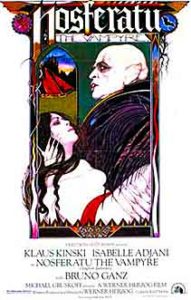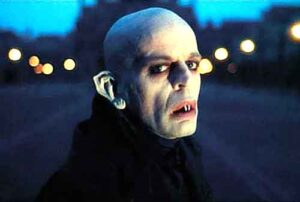One of the small handful of movie remakes that actually surpass the original, this is German filmmaker Werner Herzog’s stunning redo of F.W. Murnau’s legendary NOSFERATU. It’s a bit like the notorious Gus Van Sant shot-by-shot PSYCHO update in the way this NOSFERATU THE VAMPYRE follows Murnau’s narrative nearly verbatim and was lensed in all the same locations, but Herzog adds a fair amount of his own inscrutable genius.
F.W. Murnau’s NOSFERATU was an unauthorized adaptation of Bram Stoker’s DRACULA, but with all the names changed and the romantic sentimentality totally expunged. In its place was an incredibly vivid sense of death, disease and decay. The star was a bald, pointy-eared vampire, unforgettably portrayed by Max Schreck, who resembled nothing so much as a giant skinned rat.
NOSFERATU THE VAMPYRE 1979 (Werner Herzog Trailer)
F.W. Murnau’s NOSFERATU was an unauthorized adaptation of Bram Stoker’s DRACULA, but with all the names changed and the romantic sentimentality totally expunged.
The renowned yet cantankerous Klaus Kinski, a Werner Herzog regular (from the latter’s films AGUIRRE: THE WRATH OF GOD, WOYZECK, FITZCARRALDO and COBRA VERDE), portrayed the Schreck role in Herzog’s 1979 remake, alongside the French Isabelle Adjani (who’d just made a splash in Francois Truffaut’s THE STORY OF ADELE H.), the German Bruno Ganz and the famed French surrealist painter/writer Roland Topor. The film was shot in both German and English language versions (the latter heavily edited), as was common in European productions of the time, and distributed by Twentieth Century Fox. The release marked the fiercely idiosyncratic Herzog’s first dealings with a major Hollywood studio, who forced him to test market the film (with disastrous results) and commissioned a novelization by Paul Monette—which, I should add, is an impressive piece of work in its own right that makes for a fascinating companion-piece to the film.
NOSFERATU THE VAMPYRE was released alongside John Badham’s expensive DRACULA remake and the comedic LOVE AT FIRST BITE, and was the least financially successful of the three—and, due to legal entanglements, took nearly twenty years to reach home video in the USA (not unlike Murnau’s original, withheld from release for decades because of lawsuits filed by Bram Stoker’s widow). It has, however, endured far longer than either of those other films.
In late-1800’s Germany, real estate agent Jonathan Harker leaves his beloved wife Lucy to travel to the Transylvania castle of Count Dracula, who wants to buy a house in Harker’s neighborhood. The trip is a scenic one through rural mountains, whose superstitious inhabitants admonish Harker to advance no further upon learning of his destination. He soldiers on, though, even after his coachman elects to turn back. Harker reaches Dracula’s castle in the early evening, where he confronts a pale, subhuman, blood-drinking, daylight-hating freak—in short, a vampire. Later that night Dracula awakens Harker and drinks his blood, in the process passing the vampiric contagion on to his victim. He then locks Harker inside the castle.
The next morning Dracula departs for Harker’s hometown bearing several dirt-filled coffins. He travels via ship and kills everyone on board; when the corpse-littered vessel reaches its destination it disgorges thousands of rats from Dracula’s coffins, which spread deadly plague throughout the land.
Jonathan’s wife Lucy, meanwhile, has felt Dracula’s pull for some time, and upon his arrival falls irrefutably under his spell. It doesn’t help matters that the now fully vampirized Jonathan, having managed to break out of Dracula’s locked-up castle, arrives home and doesn’t even recognize his beloved. Lucy decides to take drastic action against the monstrous Dracula, who despite his vileness feels a real attraction to her.
Werner Herzog always concerned himself with images above all else, and the spare silent movie imagery of Murnau’s NOSFERATU proves a surprisingly potent match for Herzog’s sensibilities. His narrative is extremely minimal and not a little slow moving; shots are held far longer than normal, even by European art movie standards. Furthermore, Herzog jettisons traditional vampire movie scares in favor of a languid, atmospheric evocation of supernatural evil. The film needs to be viewed more than once, but I didn’t find doing so at all difficult, as it exerts a near-hypnotic fascination.
The cinematographer was Jorg Schmidt-Reitwein (replacing Herzog’s usual photographer Thomas Mauch), who proves himself a true master of light and shadow. It’s this aspect that really distinguishes Herzog’s NOSFERATU from Murnau’s, which has always irked me with its “night” scenes shot in broad (if blue-tinted) daylight.
And then there’s the extraordinary lead performance of Klaus Kinski. His Nosferatu is one of the most unforgettable bloodsuckers on record, a fundamentally evil yet profoundly soulful creature. Whether Kinski’s claim (in his autobiography) that he prepared for the role by enclosing himself in actual coffins is true or not, there’s no question Nosferatu remains one of his absolute finest roles.
See also:
- NOSTERATU AT 100
- HOLLYWOOD GOTHIC: THE TANGLED WEB OF DRACULA FROM NOVEL TO STAGE TO SCREEN
- DRACULA BY BRAM STOKER (Book)
- KEN RUSSELL’S DRACULA (Screenplay)
Vital Statistics
NOSFERATU THE VAMPYRE (NOSFERATU: PHANTOM DER NACHT)
Werner Herzog Filmproduktion/Twentieth Century Fox
Director: Werner Herzog
Producers: Michael Gruskoff, Werner Herzog, Daniel Toscan du Plantier
Screenplay: Werner Herzog
Cinematography: Jorg Schmidt-Reitwein
Editing: Beate Mainka-Jellinghaus
Cast: Klaus Kinski, Isabelle Adjani, Bruno Ganz, Roland Topor, Walter Ladengast, Dan Van Husen, Joe Groth, Carsten Bodinus, Martje Grohmann, Rijk de Gooyer, Clemens Sheitz, Lo van Hensbergen, John Leddy, Tim Beekman






